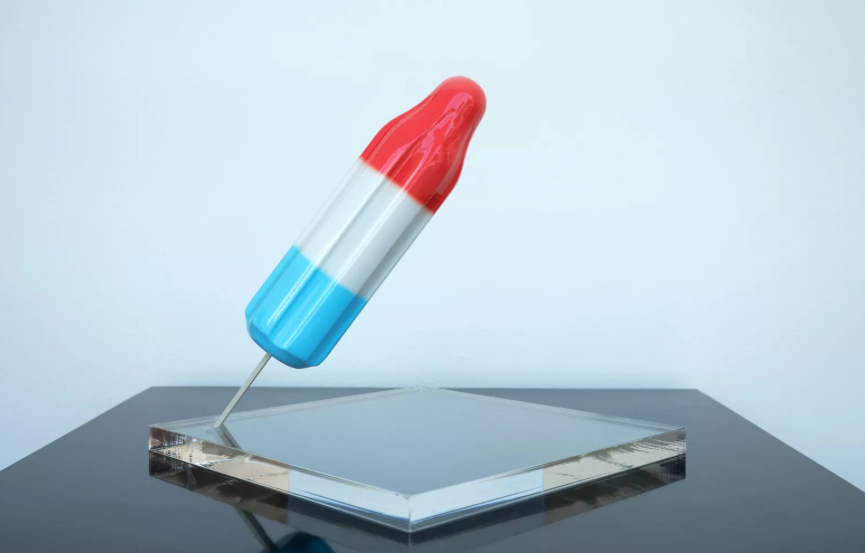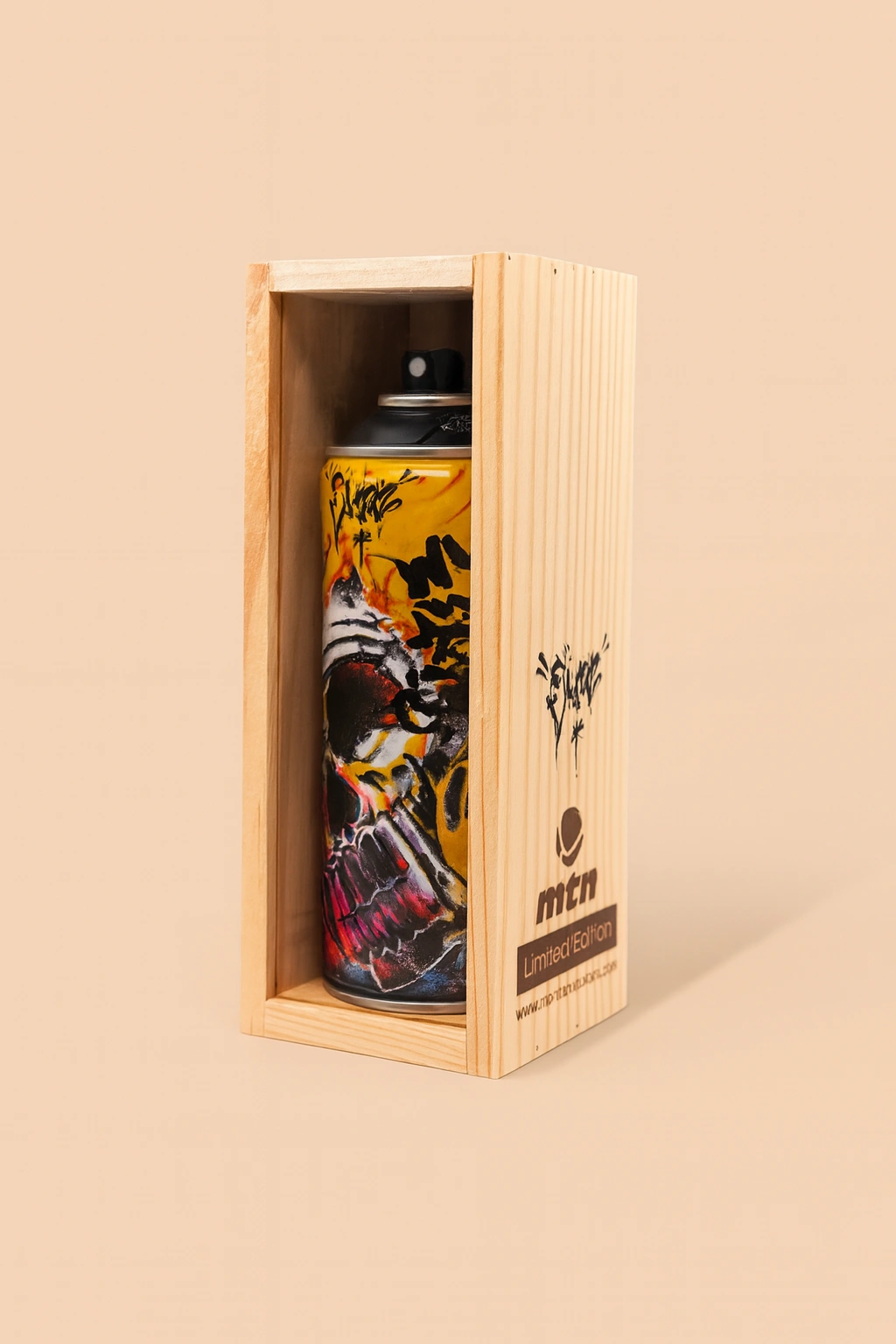In the language of contemporary American art, Derrick Adams speaks with refreshing clarity—bold, geometric, and defiantly joyful. His 2023 sculpture Cool Down Pop (RWB), AP5 is emblematic of a deeper visual philosophy: one that sees Black leisure not as an escape, but as resistance. Fashioned from painted aluminum, the piece mimics a red-white-and-blue popsicle—a familiar summertime symbol—but it stands not simply as nostalgia, but as monument. Balanced delicately on a stainless rod, the work tilts upward, as though it were both melting and ascending. It’s pop art, but not Warhol’s; it’s sculptural, but not Koons’. It is Adams’ own vocabulary, forged from memory, media, and movement.
The Form and Material: Aluminum Memory
At first glance, Cool Down Pop (RWB) reads like a minimalist totem of summer. Rendered in crisp tri-color bands—red, white, and blue—it is unmistakably modeled after the iconic Bomb Pop frozen treat, long associated with American childhood. However, unlike the actual popsicle, which melts and disappears, Adams’ sculpture remains preserved in painted aluminum. It does not dissolve in heat; it endures.
The upward-angled stick disrupts any illusion of it merely sitting on a plinth. Instead, it hovers, tilted just-so, as if escaping gravity, or floating like a flag caught mid-wave. There’s a quiet poetry in that motion—this isn’t just an object of consumption, but a celebration of transcendence. The use of industrial material—aluminum—marries the weight of permanence with the playfulness of pop.
The platform beneath the sculpture, an immaculate clear plinth, acts as both pedestal and lens, offering a reflective portal that feels less museum display and more shrine. In this respect, Adams elevates the ephemeral, granting dignity and endurance to fleeting pleasures.
A Radical Leisure: Rest as Resistance
Derrick Adams is widely known for work that celebrates Black joy, domesticity, and respite. His practice undermines the dominant cultural narrative that often frames Black life in America through trauma. With Cool Down Pop (RWB), Adams reminds us of a revolutionary truth: to rest is to resist.
The piece belongs to his broader “Floater” and “Style Variations” language—projects that champion Black presence in spaces of ease and glamour. Adams insists that the mundane—lounging by a pool, eating an ice pop, relaxing in sunglasses—are acts of cultural recovery. In a society that has long denied these simple pleasures to Black citizens, their representation becomes politically charged.
The popsicle is thus more than a snack—it’s a symbol of access. It conjures memories of hot summers, community gatherings, ice cream trucks echoing down city streets. By freezing it in time and space, Adams asserts its place in the canon of fine art, while asserting its cultural weight within Black American identity.
Pop Language, Political Echo
There is a historical lineage between Adams’ pop-informed aesthetics and mid-20th-century Pop Art. Yet, unlike his predecessors—Warhol’s detached consumer commentary or Lichtenstein’s mass-media deconstructions—Adams injects emotional resonance and autobiographical texture into the familiar.
His use of red, white, and blue is far from accidental. These are the colors of the American flag, yes—but they are also raced and loaded. For Black Americans, patriotism often exists in tension with historical and contemporary oppression. In Cool Down Pop (RWB), the flag is not unfurled—it’s stylized into something consumable, pleasurable, and personal. The object becomes an inversion of nationalist iconography. Here, the nation is not defined by state symbols or military might, but by a moment of peace beneath the summer sun.
Thus, Adams challenges the boundaries between pop and propaganda, joy and justice. The popsicle becomes a stand-in for lived experience: sugary, temporal, but worthy of preservation.
The Artist’s Practice: A Collage of Joy and Geography
Born in Baltimore in 1970, and based in Brooklyn, Derrick Adams is a Pratt- and Columbia-educated artist whose practice spans media and meaning. His collage-based portraits have been widely celebrated for their mosaic surfaces—fragments assembled into wholeness—and for their luminous portrayals of Black life beyond hardship.
“I’m really interested in the idea of normalcy in Black life,” Adams has stated, “and how that can be powerful in itself.” That sentiment runs through Cool Down Pop (RWB). The sculpture’s smooth surface may appear sterile to some, but its resonance is deeply textured—especially for viewers who recognize in it an echo of lived, local experience.
His works have been exhibited globally—in New York, Paris, Rome, London, Miami, and Johannesburg—and are included in the permanent collections of the Whitney Museum, the Met, and the Virginia Museum of Fine Arts. Yet even with this institutional validation, Adams’ work remains grounded in the personal. He doesn’t offer universalist abstractions, but specificities—objects and rituals with cultural precision and emotional relevance.
Market and Institutional Recognition
As of 2025, Adams’ works continue to achieve significant presence in the secondary market, with sculptures and large-scale canvases regularly commanding six figures. But what is notable is how this market success has not diluted his message or caused a departure from community-rooted motifs.
In fact, Cool Down Pop (RWB)—especially in its Artist’s Proof (AP5) designation—functions as both artifact and signal. To collectors, it is an investment. To museums, a curatorial must-have. But to communities that recognize the object for what it references—a memory, a heatwave, a city block, a joy rarely monumentalized—it is validation.
Adams has carved a lane between commercial accessibility and museum-grade sophistication, all while maintaining a voice that feels both local and global. His popsicle sculpture is not ironic; it is earnest. It doesn’t parody consumption—it reclaims it.
A Visual Poem, A Cultural Memorial
In formal terms, Cool Down Pop (RWB) is spare and elegant. It lacks the jagged surface fragmentation seen in his collage works. It is smooth, symmetrical, and highly polished. Yet beneath that sleekness lies a conceptual complexity.
It is a memorial to pleasure.
It is a monument to childhood and heat.
It is a statement that joy—especially Black joy—is not frivolous, but foundational.
And in a moment when American culture is contending with whose histories are told, whose bodies are represented, and whose moments of celebration are canonized, Derrick Adams lifts a popsicle into the realm of fine art—and into the sky.
Ideologue
Derrick Adams’ Cool Down Pop (RWB), AP5 is much more than a play on frozen treats. It is a vibrant testimony to the power of sculpture to carry memory, meaning, and resistance. Through minimal form and maximal symbolism, Adams distills decades of overlooked beauty into a single upward gesture. His red, white, and blue do not salute the flag—but the freedom to rest, the right to play, and the dignity in being seen.
In an art world saturated with spectacle, Adams offers serenity.
In a canon too often defined by crisis, he delivers coolness.
And in a country still thawing from its histories, he hands us something sweet.
No comments yet.








